-
 Hundred Horses
Hundred Horses This is an early painting by Giuseppe Castiglione, one of the most famous Europeans in the service of the Ch’ing dynasty court. This handscroll more than seven meters long depicts a scene of taking a herd of horses out to pasture in autumn. The hundred steeds are shown in a variety of poses and activities as they leisurely make their way around the pastures and trees. Castiglione, using refined gradations of light and shadow, has rendered an exceptionally realistic scene. Although the painting compositionally represents a continuation of traditional arrangements of herding horses in Chinese art, the placement and depiction of the trees and landscape elements clearly reveal the deep atmospheric effect often found in Western art. Even the sizes of the horses vary with the distance and are shown in relative proportion. Likewise, the painting method for the distant mountain rocks is distinct from that seen in traditional Chinese brushwork, with layered pigments also seen among the trees.
-
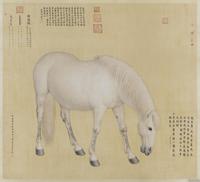 Ten Horses Depiction, Thunderclap
Ten Horses Depiction, Thunderclap Lang Shih-ning is the Chinese name of Giuseppe Castiglione, an Italian Jesuit novitiate. In 1715, he arrived in China, where his training in art came to the attention of the court. He served as a painter under the K’ang-hsi, Yung-cheng, and Ch’ien-lung emperors. He excelled at painting figures, birds and flowers, and especially dogs and horses. Castiglione was ordered by the court to paint from life fine steeds sent from the western regions as tribute. Collectively known as “The Ten Steeds”, these large works are almost life-size renderings. He added Western painting techniques of shadow and perspective to Chinese traditional methods to create colorful yet realistic portrayals. This work is a portrait of the steeds known as Thunderclap.
-
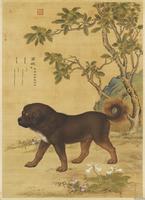 Ten Dogs Depiction, Gray Brownie
Ten Dogs Depiction, Gray Brownie Lang Shih-ning, whose original name was Giuseppe Castiglione, was a native of Milan, Italy. When he entered the Catholic priesthood at 19, he had already studied painting and architecture. AT 27 he journeyed to China as a missionary and was called to the Imperial Court to serve as a painter. He remained in the service of the Imperial Court through the reigns of three emperors: K’ang-hsi (r.1662-1723), Yung-cheng (r.1723-1735), and Ch’ien-lung (r.1736-1796). He was skilled in painting figures, birds and flowers, and he excelled particularly in painting horses and dogs. His painting style incorporated western techniques such as perspective and modelling into traditional Chinese painting. This blending resulted in beautifully rendered paintings that were extremely realistic. Tsang-ni was presented to the emperor by Fu Ch’ing, the Vice Commander-in-Chief stationed in Tibet. The title of the painting is written in Chinese, Mongolian, and Manchu. The hunting dog stands motionless amidst the tuberoses and chestnut trees. The flowers, trees, and dogs have been painted in such a manner that they look very natural and lifelike.
-
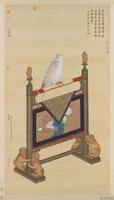 White Eagle (indoor)
White Eagle (indoor) In the first lunar month of 1765 during the Ch’ien-lung reign (1736-1795), the Doroi Beile (High Lord) Khalka submitted as tribute to the Ch’ing court a white falcon, which was painted by Giuseppe Castiglione. The white falcon here is tied to a falcon stand with yellow silk cord. Turning its head to the side, the pose is that of great realism. Among the paintings of this type with a falcon on a falcon stand, this particular piece bears an imperial inscription from 1765, indicating it is one of the last works done by Castiglione, who died the following year. Exceptional attention was paid to the details of the falcon stand, emphasizing the differences in textures and features of the objects. However, the falcon stand reveals some degree of patterning in the painting, indicating it was probably not done by Castiglione personally.
-
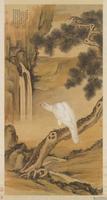 White Eagle (outdoor)
White Eagle (outdoor) Lang Shih-ning is the Chinese name used by the Italian, Giuseppe Castiglione. At the age of 19, Castiglione entered the Jesuit order in Italy as a novitiate, and his early training included painting and architecture. He was subsequently sent to China and arrived in 1715. His artistic skills came to the attention of the emperor, and he served in the inner court during the K’ang-Hsi (1662-1722), Yung-cheng (1723-1735), and Ch’ien-lung (1736-1795) reigns as a painter. He combined his previous training with studies of Chinese painting techniques to create a style fusing the best of both traditions. He excelled at depicting figures, birds and flowers, and especially dogs and horses.
-
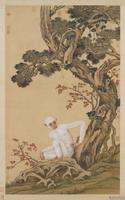 White Gibbon
White Gibbon Giuseppe Castiglione (Chinese name Lang Shih-ning) was a native of Italy. At the age of 19, he entered the Jesuit order as a novitiate. In addition to his religious training, he also studied painting and architecture. In 1715, he was sent to China, where he would spend the rest of his life as a painter in the Inner Court. He was a skilled painter of figures, flowers and birds, and especially horses and dogs. In this painting, a white gibbon sits on the root of cedar and next to red maple saplings. With one hand resting on its knee, the other scratches an itch in leisurely contemplation. The artist has not only succeeded in capturing the appearance of the gibbon, but also its disposition.
-
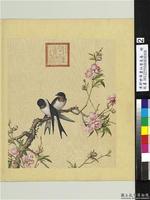 Xian'e Changchun Album - Peach Blossom
Xian'e Changchun Album - Peach Blossom This album consists of sixteen leaves divided among blossoms of the four seasons and scattered with rocks, birds, insects, and other plants. The subjects appear to have been taken from scenes in the imperial gardens, and all of them appear to have been meticulously arranged. The placement of the main and subsidiary subjects is also rendered perfectly and the coloring gorgeous, making this work a masterpiece synthesizing the best of Chinese and Western painting traditions.
-
 Xian'e Changchun Album - Lotus and Butterfly
Xian'e Changchun Album - Lotus and Butterfly Lang Shining was an Italian who entered the Jesuit order as a novitiate at the age of 19. He studied both painting and architecture. He arrived in China at the age of 27 and came to serve the Ch’ing court as a painter. He excelled at painting figures, birds and flowers, and especially dogs and horses. This is the 13th leaf from his Album of Flowers. Colorful lotus blossoms bend gently in the breeze and form a companion for the caladium water plant for a full, rich scene. Butterflies fly among them to add a fresh, cool touch to the scene. The artist fused Chinese and Western techniques. The use of Western colors, in addition to Western chiaroscuro and perspective, make for a dedicated scene that is life-like and richly colored.
-
 Xian'e Changchun Album - Bean Flower and Wheat
Xian'e Changchun Album - Bean Flower and Wheat This album consists of sixteen leaves divided among blossoms of the four seasons and scattered with rocks, birds, insects, and other plants. The subjects appear to have been taken from scenes in the imperial gardens, and all of them appear to have been meticulously arranged. The placement of the main and subsidiary subjects is also rendered perfectly and the coloring is gorgeous, making this work a masterpiece synthesizing the best of Chinese and Western painting traditions.
-
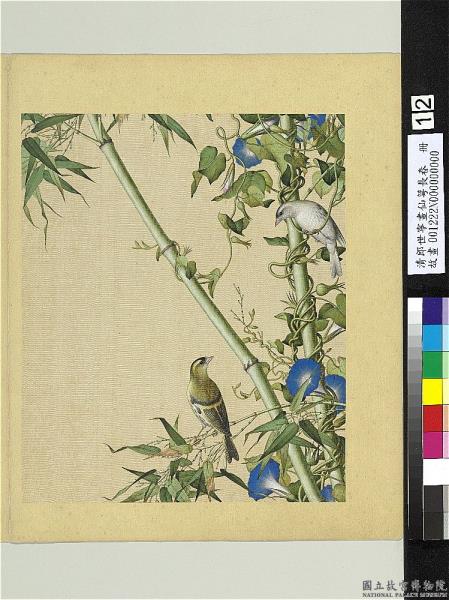 Xian'e Changchun Album - Bamboo and morning glory
Xian'e Changchun Album - Bamboo and morning glory This album consists of sixteen leaves divided among blossoms of the four seasons and scattered with rocks, birds, insects, and other plants. The subjects appear to have been taken from scenes in the imperial gardens, and all of them appear to have been meticulously arranged. The placement of the main and subsidiary subjects is also rendered perfectly and the coloring is gorgeous, making this work a masterpiece synthesizing the best of Chinese and Western painting traditions.
-
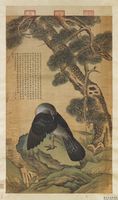 Pine and Cho-yüeh
Pine and Cho-yüeh In this painting is a depiction of a bird known as a “cho-yüeh” perched alone on an outcropping by a magnificent pine, turning its head with wing outstretched to preen its feathers. This bird is native to the regions west of China. The bird in this painting was taken back to court from the region of I-li and presented by the official A-kuei. The imperial poem inscribed on the painting is also found in the Ch’ien-lung emperor’s published collection of poetry. Composed in 1763, we thus know from this poem that Castiglione was 75 at the time painting was done.
-
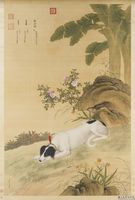 Ten Dogs Depiction, Spotted Magpie
Ten Dogs Depiction, Spotted Magpie The painter is especially well-known for his rendering of figures, flowers, birds and loger-than-life size horses and dogs. His distinctive style mode use of Chinese tools and materials to paint largely Chinese motivfs. The results were more emphatically realistic than the native Chinese tradition.
-
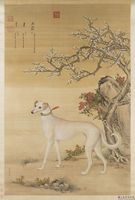 Ten Dogs Depiction, Frost Harrier
Ten Dogs Depiction, Frost Harrier This work depicts a frosty-colored hunting dog standing on a slope under white plum blossoms. Being nimble, it was named "Sparrow Hawk," hence the title here. Castiglione combined the tools and materials of Chinese painting with Western perspective and chiaroscuro for naturalism also expressing spirit. The opulent colors and forms thus make for a realistic effect. (20120102)
-
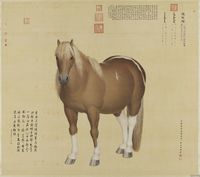 Ten Horses Depiction, Snow Scattered Eagle
Ten Horses Depiction, Snow Scattered Eagle Castiglione was commissioned to create portraits of fine horses presented as tribute from vassal states to the west for the Ch’ing court. Painted almost life-size, his use of Chinese techniques also incorporates Western methods of chiaroscuro and perspective, making the life-like colors and forms convincing. The portrait of the Ch’ih-hua-ying horse is one of set of 10 from 1743.
-
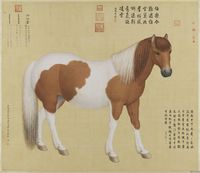 Ten Horses Depiction, Red Flower Eagle
Ten Horses Depiction, Red Flower Eagle Castiglione was commissioned to create portraits of fine horses presented as tribute from vassal states to the west for the Ch’ing court. Painted almost life-size, his use of Chinese techniques also incorporates Western methods of chiaroscuro and perspective, making the life-like colors and forms convincing. The portrait of the Ch’ih-hua-ying horse is one of set of 10 from 1743.
-
 Entertainment Scenes in Yuanmingyuan in Twelve Months, Yongzheng
Entertainment Scenes in Yuanmingyuan in Twelve Months, Yongzheng This is a group of works showing the daily life of Emperor Yongzheng, arranged in the order of 12 months in spring, summer, autumn, and winter. The paintings are mainly landscape pavilions, and the architectural descriptions are delicate, including Chinese garden buildings and Western pavilions. Terraces and pavilions, and even those who combine Chinese and Western, the landscape of the picture may be created by the painter combining the architecture of Yuanmingyuan with his imagination.
-
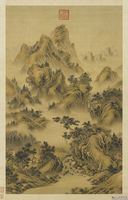 Shanshui
Shanshui Giuseppe Castiglione employed the techniques of Western painting in doing this landscape painting. As a result, the three-dimensional effect of the mountains, rocks, trees and houses is far more apparent here than in other traditional Chinese landscapes.
-
 A Brocade of Spring Radiance
A Brocade of Spring Radiance In this painting is a mountain stream flowing down to where pheasants and decorative rocks are seen. By and on the rocks are various flowers, bamboo, and spirit fungi. The subject matter is auspicious for the start of a prosperous New Year and an allusion to the expression “A Brocade of Spring Radiance”-hence, the title of this painting.
-
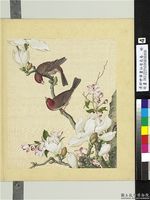 Xian'e Changchun Album - Cherry Apple & Magnolia
Xian'e Changchun Album - Cherry Apple & Magnolia This album consists of sixteen leaves divided among blossoms of the four seasons and scattered with rocks, birds, insects, and other plants. The subjects appear to have been taken from scenes in the imperial gardens, and all of them appear to have been meticulously arranged. The placement of the main and subsidiary subjects is also rendered perfectly and the coloring gorgeous, making this work a masterpiece synthesizing the best of Chinese and Western painting traditions. Selected for exhibit here are the fourth leaf on the subject of crab apple and magnolia blossoms along with the sixth leaf rendering yellow rose and bleeding heart blossoms. The signature on this album done in Sung-script style suggests it was done by Giuseppe Castiglione sometime between his arrival in China around 1715 and the early Ch’ien-lung reign (1736-1795).
-
 Xian'e Changchun Album - Chrysanthemum
Xian'e Changchun Album - Chrysanthemum This album consists of sixteen leaves divided among blossoms of the four seasons and scattered with rocks, birds, insects, and other plants. The subjects appear to have been taken from scenes in the imperial gardens, and all of them appear to have been meticulously arranged. The placement of the main and subsidiary subjects is also rendered perfectly and the coloring gorgeous, making this work a masterpiece synthesizing the best of Chinese and Western painting traditions. Selected for exhibit here are the fourth leaf on the subject of crab apple and magnolia blossoms along with the sixth leaf rendering yellow rose and bleeding heart blossoms. The signature on this album done in Sung-script style suggests it was done by Giuseppe Castiglione sometime between his arrival in China around 1715 and the early Ch’ien-lung reign (1736-1795).
 Hundred Horses This is an early painting by Giuseppe Castiglione, one of the most famous Europeans in the service of the Ch’ing dynasty court. This handscroll more than seven meters long depicts a scene of taking a herd of horses out to pasture in autumn. The hundred steeds are shown in a variety of poses and activities as they leisurely make their way around the pastures and trees. Castiglione, using refined gradations of light and shadow, has rendered an exceptionally realistic scene. Although the painting compositionally represents a continuation of traditional arrangements of herding horses in Chinese art, the placement and depiction of the trees and landscape elements clearly reveal the deep atmospheric effect often found in Western art. Even the sizes of the horses vary with the distance and are shown in relative proportion. Likewise, the painting method for the distant mountain rocks is distinct from that seen in traditional Chinese brushwork, with layered pigments also seen among the trees.
Hundred Horses This is an early painting by Giuseppe Castiglione, one of the most famous Europeans in the service of the Ch’ing dynasty court. This handscroll more than seven meters long depicts a scene of taking a herd of horses out to pasture in autumn. The hundred steeds are shown in a variety of poses and activities as they leisurely make their way around the pastures and trees. Castiglione, using refined gradations of light and shadow, has rendered an exceptionally realistic scene. Although the painting compositionally represents a continuation of traditional arrangements of herding horses in Chinese art, the placement and depiction of the trees and landscape elements clearly reveal the deep atmospheric effect often found in Western art. Even the sizes of the horses vary with the distance and are shown in relative proportion. Likewise, the painting method for the distant mountain rocks is distinct from that seen in traditional Chinese brushwork, with layered pigments also seen among the trees. Ten Horses Depiction, Thunderclap Lang Shih-ning is the Chinese name of Giuseppe Castiglione, an Italian Jesuit novitiate. In 1715, he arrived in China, where his training in art came to the attention of the court. He served as a painter under the K’ang-hsi, Yung-cheng, and Ch’ien-lung emperors. He excelled at painting figures, birds and flowers, and especially dogs and horses. Castiglione was ordered by the court to paint from life fine steeds sent from the western regions as tribute. Collectively known as “The Ten Steeds”, these large works are almost life-size renderings. He added Western painting techniques of shadow and perspective to Chinese traditional methods to create colorful yet realistic portrayals. This work is a portrait of the steeds known as Thunderclap.
Ten Horses Depiction, Thunderclap Lang Shih-ning is the Chinese name of Giuseppe Castiglione, an Italian Jesuit novitiate. In 1715, he arrived in China, where his training in art came to the attention of the court. He served as a painter under the K’ang-hsi, Yung-cheng, and Ch’ien-lung emperors. He excelled at painting figures, birds and flowers, and especially dogs and horses. Castiglione was ordered by the court to paint from life fine steeds sent from the western regions as tribute. Collectively known as “The Ten Steeds”, these large works are almost life-size renderings. He added Western painting techniques of shadow and perspective to Chinese traditional methods to create colorful yet realistic portrayals. This work is a portrait of the steeds known as Thunderclap. Ten Dogs Depiction, Gray Brownie Lang Shih-ning, whose original name was Giuseppe Castiglione, was a native of Milan, Italy. When he entered the Catholic priesthood at 19, he had already studied painting and architecture. AT 27 he journeyed to China as a missionary and was called to the Imperial Court to serve as a painter. He remained in the service of the Imperial Court through the reigns of three emperors: K’ang-hsi (r.1662-1723), Yung-cheng (r.1723-1735), and Ch’ien-lung (r.1736-1796). He was skilled in painting figures, birds and flowers, and he excelled particularly in painting horses and dogs. His painting style incorporated western techniques such as perspective and modelling into traditional Chinese painting. This blending resulted in beautifully rendered paintings that were extremely realistic. Tsang-ni was presented to the emperor by Fu Ch’ing, the Vice Commander-in-Chief stationed in Tibet. The title of the painting is written in Chinese, Mongolian, and Manchu. The hunting dog stands motionless amidst the tuberoses and chestnut trees. The flowers, trees, and dogs have been painted in such a manner that they look very natural and lifelike.
Ten Dogs Depiction, Gray Brownie Lang Shih-ning, whose original name was Giuseppe Castiglione, was a native of Milan, Italy. When he entered the Catholic priesthood at 19, he had already studied painting and architecture. AT 27 he journeyed to China as a missionary and was called to the Imperial Court to serve as a painter. He remained in the service of the Imperial Court through the reigns of three emperors: K’ang-hsi (r.1662-1723), Yung-cheng (r.1723-1735), and Ch’ien-lung (r.1736-1796). He was skilled in painting figures, birds and flowers, and he excelled particularly in painting horses and dogs. His painting style incorporated western techniques such as perspective and modelling into traditional Chinese painting. This blending resulted in beautifully rendered paintings that were extremely realistic. Tsang-ni was presented to the emperor by Fu Ch’ing, the Vice Commander-in-Chief stationed in Tibet. The title of the painting is written in Chinese, Mongolian, and Manchu. The hunting dog stands motionless amidst the tuberoses and chestnut trees. The flowers, trees, and dogs have been painted in such a manner that they look very natural and lifelike. White Eagle (indoor) In the first lunar month of 1765 during the Ch’ien-lung reign (1736-1795), the Doroi Beile (High Lord) Khalka submitted as tribute to the Ch’ing court a white falcon, which was painted by Giuseppe Castiglione. The white falcon here is tied to a falcon stand with yellow silk cord. Turning its head to the side, the pose is that of great realism. Among the paintings of this type with a falcon on a falcon stand, this particular piece bears an imperial inscription from 1765, indicating it is one of the last works done by Castiglione, who died the following year. Exceptional attention was paid to the details of the falcon stand, emphasizing the differences in textures and features of the objects. However, the falcon stand reveals some degree of patterning in the painting, indicating it was probably not done by Castiglione personally.
White Eagle (indoor) In the first lunar month of 1765 during the Ch’ien-lung reign (1736-1795), the Doroi Beile (High Lord) Khalka submitted as tribute to the Ch’ing court a white falcon, which was painted by Giuseppe Castiglione. The white falcon here is tied to a falcon stand with yellow silk cord. Turning its head to the side, the pose is that of great realism. Among the paintings of this type with a falcon on a falcon stand, this particular piece bears an imperial inscription from 1765, indicating it is one of the last works done by Castiglione, who died the following year. Exceptional attention was paid to the details of the falcon stand, emphasizing the differences in textures and features of the objects. However, the falcon stand reveals some degree of patterning in the painting, indicating it was probably not done by Castiglione personally. White Eagle (outdoor) Lang Shih-ning is the Chinese name used by the Italian, Giuseppe Castiglione. At the age of 19, Castiglione entered the Jesuit order in Italy as a novitiate, and his early training included painting and architecture. He was subsequently sent to China and arrived in 1715. His artistic skills came to the attention of the emperor, and he served in the inner court during the K’ang-Hsi (1662-1722), Yung-cheng (1723-1735), and Ch’ien-lung (1736-1795) reigns as a painter. He combined his previous training with studies of Chinese painting techniques to create a style fusing the best of both traditions. He excelled at depicting figures, birds and flowers, and especially dogs and horses.
White Eagle (outdoor) Lang Shih-ning is the Chinese name used by the Italian, Giuseppe Castiglione. At the age of 19, Castiglione entered the Jesuit order in Italy as a novitiate, and his early training included painting and architecture. He was subsequently sent to China and arrived in 1715. His artistic skills came to the attention of the emperor, and he served in the inner court during the K’ang-Hsi (1662-1722), Yung-cheng (1723-1735), and Ch’ien-lung (1736-1795) reigns as a painter. He combined his previous training with studies of Chinese painting techniques to create a style fusing the best of both traditions. He excelled at depicting figures, birds and flowers, and especially dogs and horses. White Gibbon Giuseppe Castiglione (Chinese name Lang Shih-ning) was a native of Italy. At the age of 19, he entered the Jesuit order as a novitiate. In addition to his religious training, he also studied painting and architecture. In 1715, he was sent to China, where he would spend the rest of his life as a painter in the Inner Court. He was a skilled painter of figures, flowers and birds, and especially horses and dogs. In this painting, a white gibbon sits on the root of cedar and next to red maple saplings. With one hand resting on its knee, the other scratches an itch in leisurely contemplation. The artist has not only succeeded in capturing the appearance of the gibbon, but also its disposition.
White Gibbon Giuseppe Castiglione (Chinese name Lang Shih-ning) was a native of Italy. At the age of 19, he entered the Jesuit order as a novitiate. In addition to his religious training, he also studied painting and architecture. In 1715, he was sent to China, where he would spend the rest of his life as a painter in the Inner Court. He was a skilled painter of figures, flowers and birds, and especially horses and dogs. In this painting, a white gibbon sits on the root of cedar and next to red maple saplings. With one hand resting on its knee, the other scratches an itch in leisurely contemplation. The artist has not only succeeded in capturing the appearance of the gibbon, but also its disposition. Xian'e Changchun Album - Peach Blossom This album consists of sixteen leaves divided among blossoms of the four seasons and scattered with rocks, birds, insects, and other plants. The subjects appear to have been taken from scenes in the imperial gardens, and all of them appear to have been meticulously arranged. The placement of the main and subsidiary subjects is also rendered perfectly and the coloring gorgeous, making this work a masterpiece synthesizing the best of Chinese and Western painting traditions.
Xian'e Changchun Album - Peach Blossom This album consists of sixteen leaves divided among blossoms of the four seasons and scattered with rocks, birds, insects, and other plants. The subjects appear to have been taken from scenes in the imperial gardens, and all of them appear to have been meticulously arranged. The placement of the main and subsidiary subjects is also rendered perfectly and the coloring gorgeous, making this work a masterpiece synthesizing the best of Chinese and Western painting traditions. Xian'e Changchun Album - Lotus and Butterfly Lang Shining was an Italian who entered the Jesuit order as a novitiate at the age of 19. He studied both painting and architecture. He arrived in China at the age of 27 and came to serve the Ch’ing court as a painter. He excelled at painting figures, birds and flowers, and especially dogs and horses. This is the 13th leaf from his Album of Flowers. Colorful lotus blossoms bend gently in the breeze and form a companion for the caladium water plant for a full, rich scene. Butterflies fly among them to add a fresh, cool touch to the scene. The artist fused Chinese and Western techniques. The use of Western colors, in addition to Western chiaroscuro and perspective, make for a dedicated scene that is life-like and richly colored.
Xian'e Changchun Album - Lotus and Butterfly Lang Shining was an Italian who entered the Jesuit order as a novitiate at the age of 19. He studied both painting and architecture. He arrived in China at the age of 27 and came to serve the Ch’ing court as a painter. He excelled at painting figures, birds and flowers, and especially dogs and horses. This is the 13th leaf from his Album of Flowers. Colorful lotus blossoms bend gently in the breeze and form a companion for the caladium water plant for a full, rich scene. Butterflies fly among them to add a fresh, cool touch to the scene. The artist fused Chinese and Western techniques. The use of Western colors, in addition to Western chiaroscuro and perspective, make for a dedicated scene that is life-like and richly colored. Xian'e Changchun Album - Bean Flower and Wheat This album consists of sixteen leaves divided among blossoms of the four seasons and scattered with rocks, birds, insects, and other plants. The subjects appear to have been taken from scenes in the imperial gardens, and all of them appear to have been meticulously arranged. The placement of the main and subsidiary subjects is also rendered perfectly and the coloring is gorgeous, making this work a masterpiece synthesizing the best of Chinese and Western painting traditions.
Xian'e Changchun Album - Bean Flower and Wheat This album consists of sixteen leaves divided among blossoms of the four seasons and scattered with rocks, birds, insects, and other plants. The subjects appear to have been taken from scenes in the imperial gardens, and all of them appear to have been meticulously arranged. The placement of the main and subsidiary subjects is also rendered perfectly and the coloring is gorgeous, making this work a masterpiece synthesizing the best of Chinese and Western painting traditions. Xian'e Changchun Album - Bamboo and morning glory This album consists of sixteen leaves divided among blossoms of the four seasons and scattered with rocks, birds, insects, and other plants. The subjects appear to have been taken from scenes in the imperial gardens, and all of them appear to have been meticulously arranged. The placement of the main and subsidiary subjects is also rendered perfectly and the coloring is gorgeous, making this work a masterpiece synthesizing the best of Chinese and Western painting traditions.
Xian'e Changchun Album - Bamboo and morning glory This album consists of sixteen leaves divided among blossoms of the four seasons and scattered with rocks, birds, insects, and other plants. The subjects appear to have been taken from scenes in the imperial gardens, and all of them appear to have been meticulously arranged. The placement of the main and subsidiary subjects is also rendered perfectly and the coloring is gorgeous, making this work a masterpiece synthesizing the best of Chinese and Western painting traditions. Pine and Cho-yüeh In this painting is a depiction of a bird known as a “cho-yüeh” perched alone on an outcropping by a magnificent pine, turning its head with wing outstretched to preen its feathers. This bird is native to the regions west of China. The bird in this painting was taken back to court from the region of I-li and presented by the official A-kuei. The imperial poem inscribed on the painting is also found in the Ch’ien-lung emperor’s published collection of poetry. Composed in 1763, we thus know from this poem that Castiglione was 75 at the time painting was done.
Pine and Cho-yüeh In this painting is a depiction of a bird known as a “cho-yüeh” perched alone on an outcropping by a magnificent pine, turning its head with wing outstretched to preen its feathers. This bird is native to the regions west of China. The bird in this painting was taken back to court from the region of I-li and presented by the official A-kuei. The imperial poem inscribed on the painting is also found in the Ch’ien-lung emperor’s published collection of poetry. Composed in 1763, we thus know from this poem that Castiglione was 75 at the time painting was done. Ten Dogs Depiction, Spotted Magpie The painter is especially well-known for his rendering of figures, flowers, birds and loger-than-life size horses and dogs. His distinctive style mode use of Chinese tools and materials to paint largely Chinese motivfs. The results were more emphatically realistic than the native Chinese tradition.
Ten Dogs Depiction, Spotted Magpie The painter is especially well-known for his rendering of figures, flowers, birds and loger-than-life size horses and dogs. His distinctive style mode use of Chinese tools and materials to paint largely Chinese motivfs. The results were more emphatically realistic than the native Chinese tradition. Ten Dogs Depiction, Frost Harrier This work depicts a frosty-colored hunting dog standing on a slope under white plum blossoms. Being nimble, it was named "Sparrow Hawk," hence the title here. Castiglione combined the tools and materials of Chinese painting with Western perspective and chiaroscuro for naturalism also expressing spirit. The opulent colors and forms thus make for a realistic effect. (20120102)
Ten Dogs Depiction, Frost Harrier This work depicts a frosty-colored hunting dog standing on a slope under white plum blossoms. Being nimble, it was named "Sparrow Hawk," hence the title here. Castiglione combined the tools and materials of Chinese painting with Western perspective and chiaroscuro for naturalism also expressing spirit. The opulent colors and forms thus make for a realistic effect. (20120102) Ten Horses Depiction, Snow Scattered Eagle Castiglione was commissioned to create portraits of fine horses presented as tribute from vassal states to the west for the Ch’ing court. Painted almost life-size, his use of Chinese techniques also incorporates Western methods of chiaroscuro and perspective, making the life-like colors and forms convincing. The portrait of the Ch’ih-hua-ying horse is one of set of 10 from 1743.
Ten Horses Depiction, Snow Scattered Eagle Castiglione was commissioned to create portraits of fine horses presented as tribute from vassal states to the west for the Ch’ing court. Painted almost life-size, his use of Chinese techniques also incorporates Western methods of chiaroscuro and perspective, making the life-like colors and forms convincing. The portrait of the Ch’ih-hua-ying horse is one of set of 10 from 1743. Ten Horses Depiction, Red Flower Eagle Castiglione was commissioned to create portraits of fine horses presented as tribute from vassal states to the west for the Ch’ing court. Painted almost life-size, his use of Chinese techniques also incorporates Western methods of chiaroscuro and perspective, making the life-like colors and forms convincing. The portrait of the Ch’ih-hua-ying horse is one of set of 10 from 1743.
Ten Horses Depiction, Red Flower Eagle Castiglione was commissioned to create portraits of fine horses presented as tribute from vassal states to the west for the Ch’ing court. Painted almost life-size, his use of Chinese techniques also incorporates Western methods of chiaroscuro and perspective, making the life-like colors and forms convincing. The portrait of the Ch’ih-hua-ying horse is one of set of 10 from 1743. Entertainment Scenes in Yuanmingyuan in Twelve Months, Yongzheng This is a group of works showing the daily life of Emperor Yongzheng, arranged in the order of 12 months in spring, summer, autumn, and winter. The paintings are mainly landscape pavilions, and the architectural descriptions are delicate, including Chinese garden buildings and Western pavilions. Terraces and pavilions, and even those who combine Chinese and Western, the landscape of the picture may be created by the painter combining the architecture of Yuanmingyuan with his imagination.
Entertainment Scenes in Yuanmingyuan in Twelve Months, Yongzheng This is a group of works showing the daily life of Emperor Yongzheng, arranged in the order of 12 months in spring, summer, autumn, and winter. The paintings are mainly landscape pavilions, and the architectural descriptions are delicate, including Chinese garden buildings and Western pavilions. Terraces and pavilions, and even those who combine Chinese and Western, the landscape of the picture may be created by the painter combining the architecture of Yuanmingyuan with his imagination. Shanshui Giuseppe Castiglione employed the techniques of Western painting in doing this landscape painting. As a result, the three-dimensional effect of the mountains, rocks, trees and houses is far more apparent here than in other traditional Chinese landscapes.
Shanshui Giuseppe Castiglione employed the techniques of Western painting in doing this landscape painting. As a result, the three-dimensional effect of the mountains, rocks, trees and houses is far more apparent here than in other traditional Chinese landscapes. A Brocade of Spring Radiance In this painting is a mountain stream flowing down to where pheasants and decorative rocks are seen. By and on the rocks are various flowers, bamboo, and spirit fungi. The subject matter is auspicious for the start of a prosperous New Year and an allusion to the expression “A Brocade of Spring Radiance”-hence, the title of this painting.
A Brocade of Spring Radiance In this painting is a mountain stream flowing down to where pheasants and decorative rocks are seen. By and on the rocks are various flowers, bamboo, and spirit fungi. The subject matter is auspicious for the start of a prosperous New Year and an allusion to the expression “A Brocade of Spring Radiance”-hence, the title of this painting. Xian'e Changchun Album - Cherry Apple & Magnolia This album consists of sixteen leaves divided among blossoms of the four seasons and scattered with rocks, birds, insects, and other plants. The subjects appear to have been taken from scenes in the imperial gardens, and all of them appear to have been meticulously arranged. The placement of the main and subsidiary subjects is also rendered perfectly and the coloring gorgeous, making this work a masterpiece synthesizing the best of Chinese and Western painting traditions. Selected for exhibit here are the fourth leaf on the subject of crab apple and magnolia blossoms along with the sixth leaf rendering yellow rose and bleeding heart blossoms. The signature on this album done in Sung-script style suggests it was done by Giuseppe Castiglione sometime between his arrival in China around 1715 and the early Ch’ien-lung reign (1736-1795).
Xian'e Changchun Album - Cherry Apple & Magnolia This album consists of sixteen leaves divided among blossoms of the four seasons and scattered with rocks, birds, insects, and other plants. The subjects appear to have been taken from scenes in the imperial gardens, and all of them appear to have been meticulously arranged. The placement of the main and subsidiary subjects is also rendered perfectly and the coloring gorgeous, making this work a masterpiece synthesizing the best of Chinese and Western painting traditions. Selected for exhibit here are the fourth leaf on the subject of crab apple and magnolia blossoms along with the sixth leaf rendering yellow rose and bleeding heart blossoms. The signature on this album done in Sung-script style suggests it was done by Giuseppe Castiglione sometime between his arrival in China around 1715 and the early Ch’ien-lung reign (1736-1795). Xian'e Changchun Album - Chrysanthemum This album consists of sixteen leaves divided among blossoms of the four seasons and scattered with rocks, birds, insects, and other plants. The subjects appear to have been taken from scenes in the imperial gardens, and all of them appear to have been meticulously arranged. The placement of the main and subsidiary subjects is also rendered perfectly and the coloring gorgeous, making this work a masterpiece synthesizing the best of Chinese and Western painting traditions. Selected for exhibit here are the fourth leaf on the subject of crab apple and magnolia blossoms along with the sixth leaf rendering yellow rose and bleeding heart blossoms. The signature on this album done in Sung-script style suggests it was done by Giuseppe Castiglione sometime between his arrival in China around 1715 and the early Ch’ien-lung reign (1736-1795).
Xian'e Changchun Album - Chrysanthemum This album consists of sixteen leaves divided among blossoms of the four seasons and scattered with rocks, birds, insects, and other plants. The subjects appear to have been taken from scenes in the imperial gardens, and all of them appear to have been meticulously arranged. The placement of the main and subsidiary subjects is also rendered perfectly and the coloring gorgeous, making this work a masterpiece synthesizing the best of Chinese and Western painting traditions. Selected for exhibit here are the fourth leaf on the subject of crab apple and magnolia blossoms along with the sixth leaf rendering yellow rose and bleeding heart blossoms. The signature on this album done in Sung-script style suggests it was done by Giuseppe Castiglione sometime between his arrival in China around 1715 and the early Ch’ien-lung reign (1736-1795).